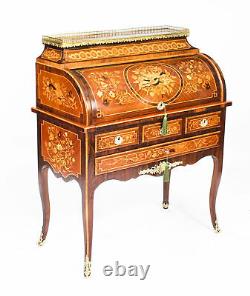
- Home
- Features
- 8-day (19)
- Aceo, Miniature (6)
- Antique (31)
- Boxed (9)
- Carvings (26)
- Decorative (19)
- Framed (32)
- Framed, Signed (7)
- Gilded (85)
- Gilded, Pair (93)
- Hand Painted (14)
- Limited Edition (8)
- One Of A Kind (ooak) (17)
- Ornate (20)
- Pair (151)
- Reclaimed (13)
- Roses Grapes (6)
- Salvage (49)
- Signed (17)
- Updated Wiring (8)
- ... (3410)
- Finish
- Item Height
- Item Length
- Shape
- Size
Antique French Louis XV Revival Marquetry Bureau c. 1870 19th Century



Regent Antiques has been trading in London for three decades. We specialise in English and Continental antique furniture, silver and porcelain. Our main markets are Europe and North America and we export worldwide. Antique French Louis XV Revival Marquetry Bureau c. This is a gorgeous antique French kingwood &.
Secretaire a cylindre, circa 1870 in date. It is decorated throughout with beautiful floral marquetry with trophies, lovebirds and flowering stems, the centre of the cylinder has a stunning oval marquetry panel with a musical instruments. It has a beautiful inset Marmo Griotte. Marble top with a gilt brass three quarter gallery around it. The cylinder opens to reveal a fitted interior with four small drawers and a pull out writing surface fitted with an inset gold tooled leather writing surface, so there is ample space to write your letters.Below the cylinder are five small drawers with space for all your pens paper and envelopes. The bureau has its original ormolu handles and mounts and stands on gorgeous ormolu mounted cabriole legs. Complete with working locks and original keys.
It is a fabulous decorative piece which will look amazing wherever you decide to place it. Condition: In excellent condition having been beautifully cleaned, polished and waxed in our workshops, please see photos for confirmation. Height 109 x Width 90 x Depth 47. Height 42.9 x Width 35.4 x Depth 18.5.
Is a classic furniture wood, almost exclusively used for inlays on very fine furniture. Occasionally it is used in the solid for small items and turned work, including parts of billiard cues, e. It is brownish-purple with many fine darker stripes and occasional irregular swirls.Occasionally it contains pale streaks of a similar. The wood is very dense and hard and can be brought to a spectacular finish. It turns well but due to its density and hardness can be difficult to work with hand tools.
It also has a tendency to blunt the tools due to its abrasive properties. Is decorative artistry where pieces of material (such as wood, mother of pearl, pewter, brass silver or shell) of different colours are inserted into surface wood veneer to form intricate patterns such as scrolls or flowers. The technique of veneered marquetry had its inspiration in 16th century. Marquetry elaborated upon Florentine techniques of inlaying solid marble slabs with designs formed of fitted marbles, jaspers and semi-precious stones. This work, called opere di commessi, has medieval parallels in Central Italian.
Work of inlaid marble floors, altars and columns. The technique is known in English as. Chapel of the Medici at San Lorenzo. Is completely covered in a colored marble facing using this demanding jig-sawn technique. Techniques of wood marquetry were developed in. And other Flemish centers of luxury. During the early 16th century. The craft was imported full-blown to France after the mid-seventeenth century, to create furniture of unprecedented luxury being made at the. Royal manufactory of the Gobelins. Charged with providing furnishings to decorate. And the other royal residences of. Early masters of French marquetry were the Fleming.Who founded a dynasty of royal and Parisian cabinet-makers. And gave his name to a technique of marquetry employing shell and brass with pewter in. Ormolu (from French'or moulu', signifying ground or pounded gold) is an 18th-century English term for applying finely ground, high-carat.
The mercury is driven off in a. Leaving behind a gold-coloured veneer known as'gilt bronze'. The manufacture of true ormolu employs a process known as mercury-gilding or fire-gilding. In which a solution of nitrate of mercury. Is applied to a piece of copper.
Or bronze, followed by the application of an amalgam. The item was then exposed to extreme heat until the mercury burned off and the gold remained, adhered to the metal object. No true ormolu was produced in France after around 1830 because legislation had outlawed the use of mercury.
Therefore, other techniques were used instead but nothing surpasses the original mercury-firing ormolu method for sheer beauty and richness of colour. Is the most common modern technique. Ormolu techniques are essentially the same as those used on silver. Griotte marble - is named after the griotte cherry because of its remarkable bright red colour.
The more red the marble, the higher quality it is. When the marble contains many goniatites (small fossilized shells) full of white calcite the marble is called "Partridge eye". The quarries, still active today, are in the Herault region and the name "Griotte from Italy" is a marketing label. Red Griotte was the favourite marble for Royal apartments in the 18th century, particularly for mantles, like the one in the office of Louis XIV in Versailles.
Take a tour of our London showrooms. Take Piccadilly line to Manor House station. Go to top of escalators and turn left.Take exit 7 and walk straight on for 10 metres. Manor Warehouse is on the right. There is car parking available on site.
Please make all cheques payable to Regent Antiques. Bank details: Regent Antiques - BBVA - Account: 05701615 - Sort: 23-59-11. For the best value, we recommend offsetting this cost by purchasing multiple items. The item "Antique French Louis XV Revival Marquetry Bureau c.
1870 19th Century" is in sale since Tuesday, December 10, 2019. This item is in the category "Antiques\Antique Furniture\Bureaux\Victorian (1837-1901)". The seller is "regentantiquesuk" and is located in London N4 1BX.
This item can be shipped worldwide.

